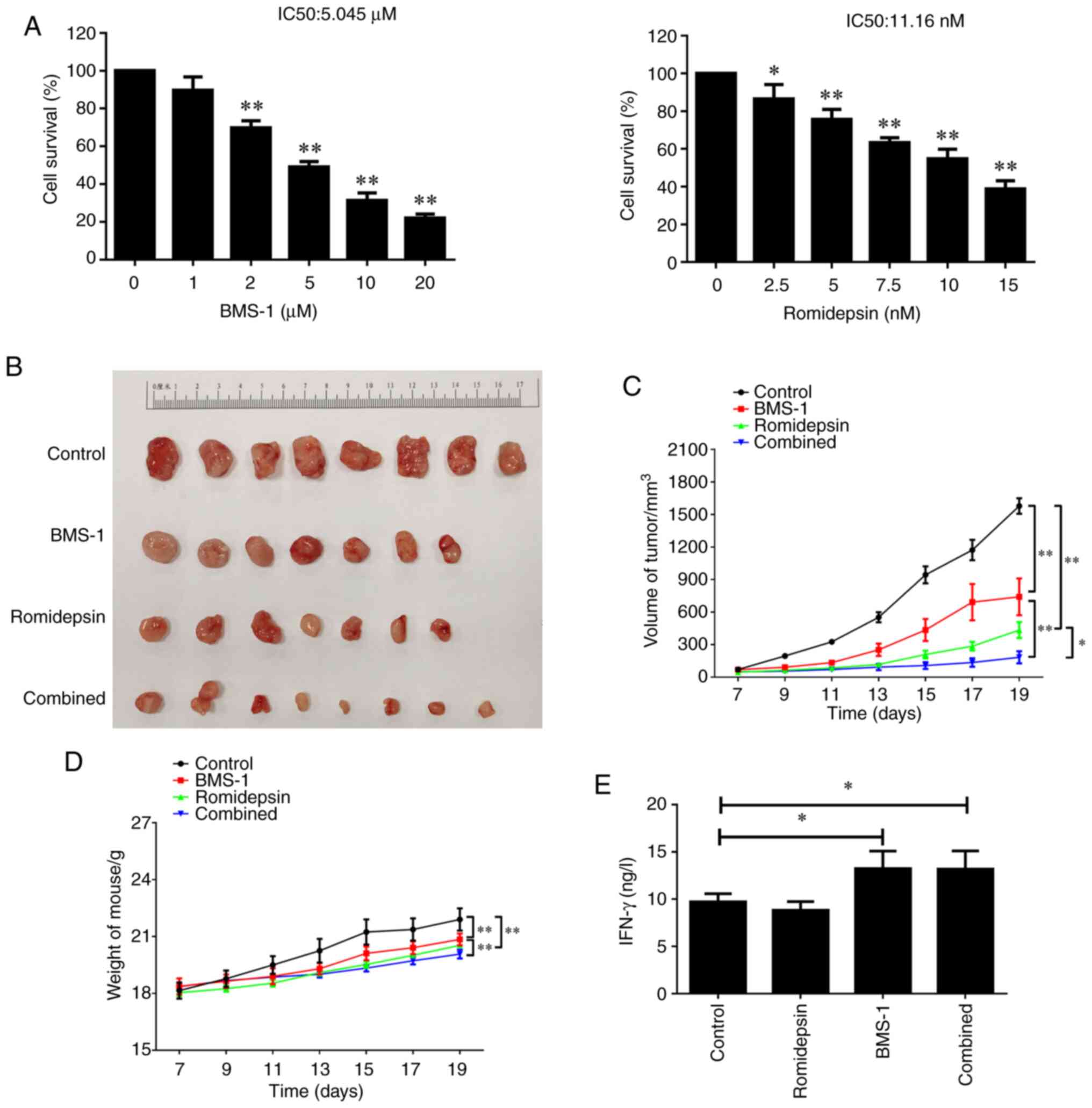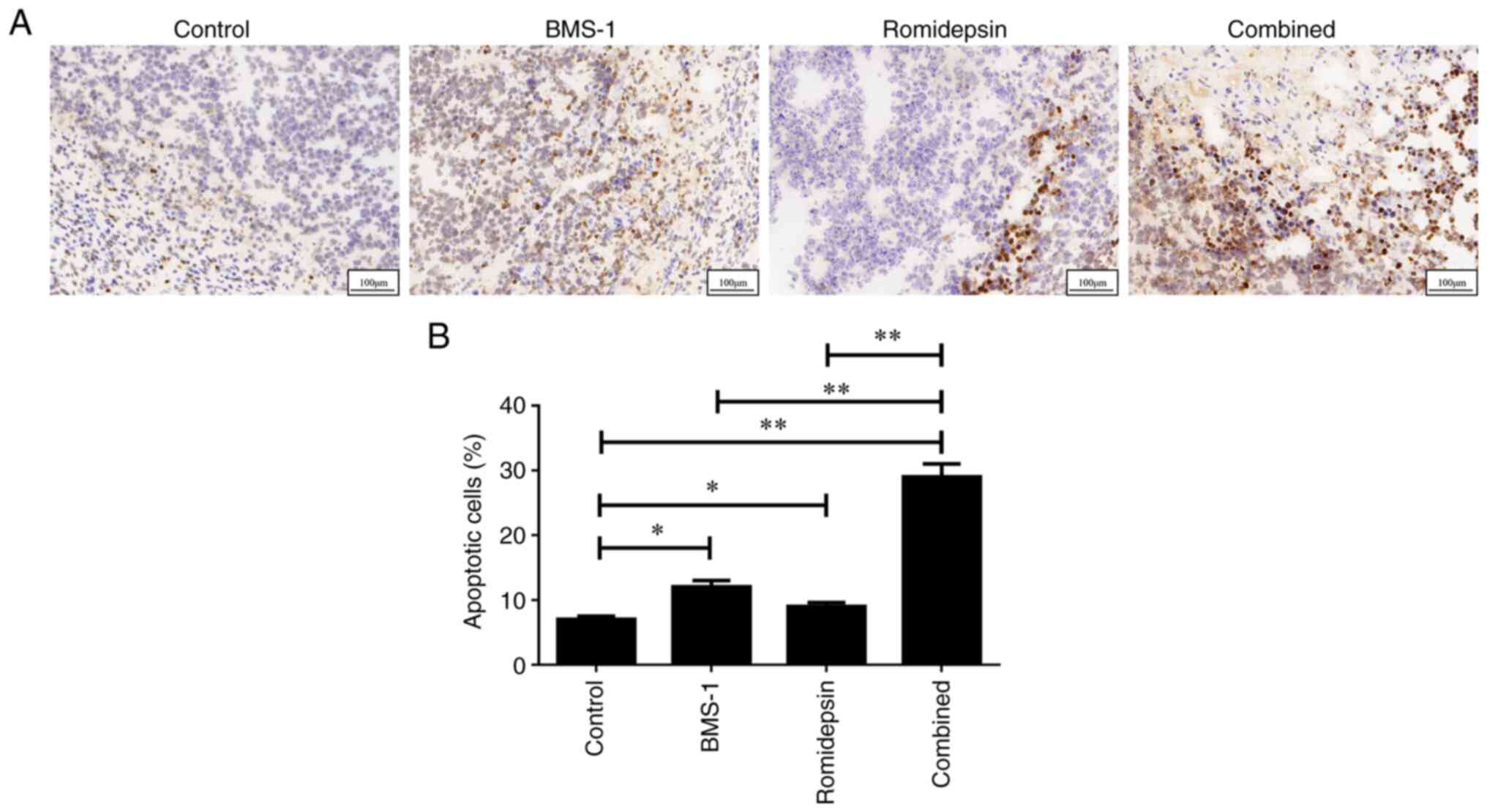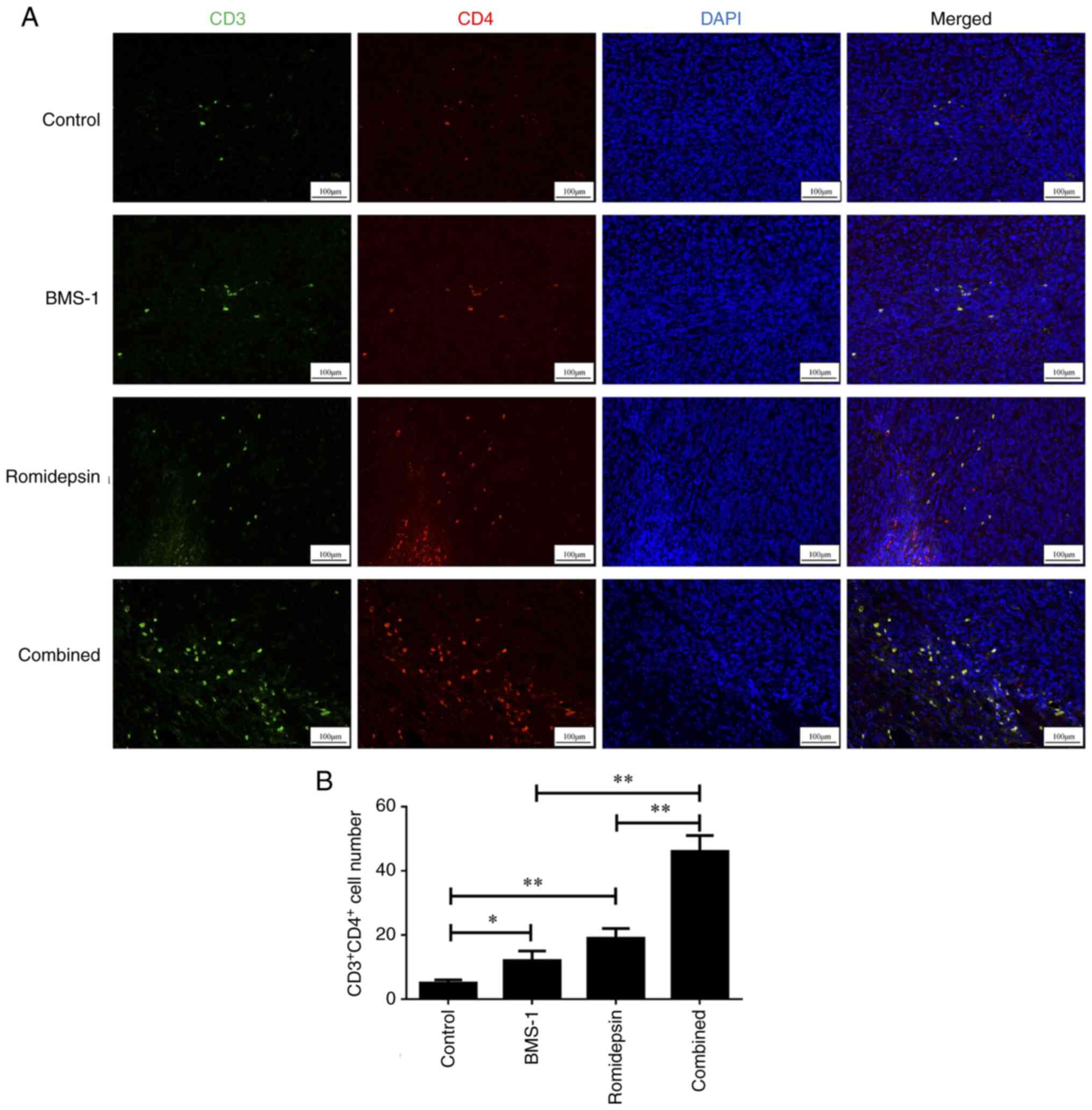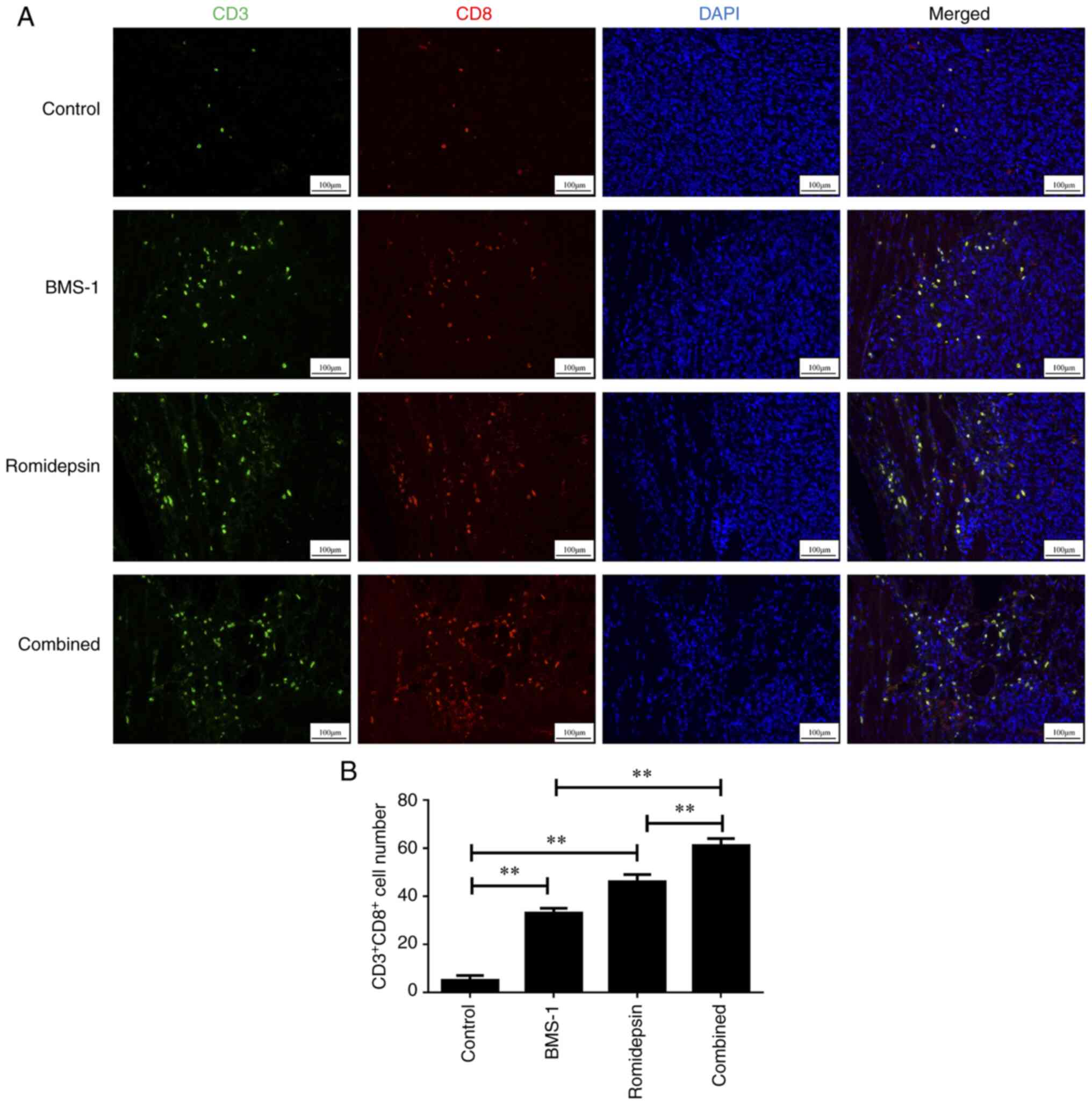|
1
|
Al-Hamadani M, Habermann TM, Cerhan JR,
Macon WR, Maurer MJ and Go RS: Non-Hodgkin lymphoma subtype
distribution, geodemographic patterns, and survival in the US: A
longitudinal analysis of the National Cancer Data Base from 1998 to
2011. Am J Hematol. 90:790–795. 2015. View Article : Google Scholar : PubMed/NCBI
|
|
2
|
Ansell SM, Lesokhin AM, Borrello I,
Halwani A, Scott EC, Gutierrez M, Schuster SJ, Millenson MM, Cattry
D, Freeman GJ, et al: PD-1 blockade with nivolumab in relapsed or
refractory Hodgkin's lymphoma. N Engl J Med. 372:311–319. 2015.
View Article : Google Scholar : PubMed/NCBI
|
|
3
|
Fourcade J, Sun Z, Benallaoua M, Guillaume
P, Luescher IF, Sander C, Kirkwood JM, Kuchroo V and Zarour HM:
Upregulation of Tim-3 and PD-1 expression is associated with tumor
antigen-specific CD8+ T cell dysfunction in melanoma patients. J
Exp Med. 207:2175–2186. 2010. View Article : Google Scholar : PubMed/NCBI
|
|
4
|
Shaw G, Cavalcante L, Giles FJ and Taylor
A: Elraglusib (9-ING-41), a selective small-molecule inhibitor of
glycogen synthase kinase-3 beta, reduces expression of immune
checkpoint molecules PD-1, TIGIT and LAG-3 and enhances CD8(+) T
cell cytolytic killing of melanoma cells. J Hematol Oncol.
15:1342022. View Article : Google Scholar : PubMed/NCBI
|
|
5
|
Xu C, Xie X, Kang N and Jiang H:
Neoadjuvant PD-1 inhibitor and apatinib combined with S-1 plus
oxaliplatin for locally advanced gastric cancer patients: A
multicentered, prospective, cohort study. J Cancer Res Clin Oncol.
149:4091–4099. 2023. View Article : Google Scholar : PubMed/NCBI
|
|
6
|
Liu J, Wei L, Hu N, Wang D, Ni J, Zhang S,
Liu H, Lv T, Yin J, Ye M and Song Y: FBW7-mediated ubiquitination
and destruction of PD-1 protein primes sensitivity to anti-PD-1
immunotherapy in non-small cell lung cancer. J Immunother Cancer.
10:e0051162022. View Article : Google Scholar : PubMed/NCBI
|
|
7
|
Nagai Y, Sata M, Ohta H, Onuki T, Saito T,
Uchiyama A, Kurosaki A, Yoshizumi N, Takigami A, Nakazawa S, et al:
Herpes zoster in patients with lung cancer treated with PD-1/PD-L1
antibodies. Immunotherapy. 14:1211–1217. 2022. View Article : Google Scholar : PubMed/NCBI
|
|
8
|
Jimenez O, Mangiaterra T, Colli S, Garcia
Lombardi M, Preciado MV, De Matteo E and Chabay P: PD-1 and LAG-3
expression in EBV-associated pediatric Hodgkin lymphoma has
influence on survival. Front Oncol. 12:9572082022. View Article : Google Scholar : PubMed/NCBI
|
|
9
|
Rossi C and Casasnovas RO: PD-1 inhibitors
in patients with Hodgkin lymphoma. Eur J Cancer. 164:114–116. 2022.
View Article : Google Scholar : PubMed/NCBI
|
|
10
|
Zain J and O'Connor OA: Targeting histone
deacetyalses in the treatment of B- and T-cell malignancies. Invest
New Drugs. 28 Suppl 1 (Suppl 1):S58–S78. 2010. View Article : Google Scholar : PubMed/NCBI
|
|
11
|
Shin DY, Kim A, Kang HJ, Park S, Kim DW
and Lee SS: Histone deacetylase inhibitor romidepsin induces
efficient tumor cell lysis via selective down-regulation of LMP1
and c-myc expression in EBV-positive diffuse large B-cell lymphoma.
Cancer Lett. 364:89–97. 2015. View Article : Google Scholar : PubMed/NCBI
|
|
12
|
Yu H, Mi L, Zhang W, Ye Y, Li M, Hu D, Cao
J, Wang D, Wang X, Ding N, et al: Ibrutinib combined with low-dose
histone deacetylases inhibitor chidamide synergistically enhances
the anti-tumor effect in B-cell lymphoma. Hematol Oncol.
40:894–905. 2022. View
Article : Google Scholar : PubMed/NCBI
|
|
13
|
Wang P, Wang Z and Liu J: Role of HDACs in
normal and malignant hematopoiesis. Mol Cancer. 19:52020.
View Article : Google Scholar : PubMed/NCBI
|
|
14
|
Chuang DM, Leng Y, Marinova Z, Kim HJ and
Chiu CT: Multiple roles of HDAC inhibition in neurodegenerative
conditions. Trends Neurosci. 32:591–601. 2009. View Article : Google Scholar : PubMed/NCBI
|
|
15
|
Consalvi S, Saccone V, Giordani L, Minetti
G, Mozzetta C and Puri PL: Histone deacetylase inhibitors in the
treatment of muscular dystrophies: Epigenetic drugs for genetic
diseases. Mol Med. 17:457–465. 2011. View Article : Google Scholar : PubMed/NCBI
|
|
16
|
Yang FF, Hu T, Liu JQ, Yu XQ and Ma LY:
Histone deacetylases (HDACs) as the promising immunotherapeutic
targets for hematologic cancer treatment. Eur J Med Chem. 245((Pt
2)): 1149202023. View Article : Google Scholar : PubMed/NCBI
|
|
17
|
Marks PA: The clinical development of
histone deacetylase inhibitors as targeted anticancer drugs. Expert
Opin Investig Drugs. 19:1049–1066. 2010. View Article : Google Scholar : PubMed/NCBI
|
|
18
|
Wang L, Wu Z, Xia Y, Lu X, Li J, Fan L,
Qiao C, Qiu H, Gu D, Xu W, et al: Single-cell profiling-guided
combination therapy of c-Fos and histone deacetylase inhibitors in
diffuse large B-cell lymphoma. Clin Transl Med. 12:e7982022.
View Article : Google Scholar : PubMed/NCBI
|
|
19
|
Llopiz D, Ruiz M, Villanueva L, Iglesias
T, Silva L, Egea J, Lasarte JJ, Pivette P, Trochon-Joseph V,
Vasseur B, et al: Enhanced anti-tumor efficacy of checkpoint
inhibitors in combination with the histone deacetylase inhibitor
Belinostat in a murine hepatocellular carcinoma model. Cancer
Immunol Immunother. 68:379–393. 2019. View Article : Google Scholar : PubMed/NCBI
|
|
20
|
Burke B, Eden C, Perez C, Belshoff A, Hart
S, Plaza-Rojas L, Delos Reyes M, Prajapati K, Voelkel-Johnson C,
Henry E, et al: Inhibition of histone deacetylase (HDAC) enhances
checkpoint blockade efficacy by rendering bladder cancer cells
visible for T cell-mediated destruction. Front Oncol. 10:6992020.
View Article : Google Scholar : PubMed/NCBI
|
|
21
|
Wu C, Song Q, Gao S and Wu S: Targeting
HDACs for diffuse large B-cell lymphoma therapy. Sci Rep.
14:2892024. View Article : Google Scholar : PubMed/NCBI
|
|
22
|
McClure JJ, Li X and Chou CJ: Advances and
challenges of HDAC inhibitors in cancer therapeutics. Adv Cancer
Res. 138:183–211. 2018. View Article : Google Scholar : PubMed/NCBI
|
|
23
|
Mann BS, Johnson JR, Cohen MH, Justice R
and Pazdur R: FDA approval summary: Vorinostat for treatment of
advanced primary cutaneous T-cell lymphoma. Oncologist.
12:1247–1252. 2007. View Article : Google Scholar : PubMed/NCBI
|
|
24
|
Squarzoni A, Scuteri A and Cavaletti G:
HDACi: The columbus' egg in improving cancer treatment and reducing
neurotoxicity? Cancers (Basel). 14:52512022. View Article : Google Scholar : PubMed/NCBI
|
|
25
|
Bachy E, Camus V, Thieblemont C, Sibon D,
Casasnovas RO, Ysebaert L, Damaj G, Guidez S, Pica GM, Kim WS, et
al: Romidepsin Plus CHOP Versus CHOP in patients with previously
untreated peripheral T-Cell Lymphoma: Results of the Ro-CHOP phase
III study (Conducted by LYSA). J Clin Oncol. 40:242–251. 2022.
View Article : Google Scholar : PubMed/NCBI
|
|
26
|
Tsuruta A, Shiiba Y, Matsunaga N, Fujimoto
M, Yoshida Y, Koyanagi S and Ohdo S: Diurnal Expression of PD-1 on
tumor-associated macrophages underlies the dosing time-dependent
antitumor effects of the PD-1/PD-L1 Inhibitor BMS-1 in B16/BL6
Melanoma-Bearing Mice. Mol Cancer Res. 20:972–982. 2022. View Article : Google Scholar : PubMed/NCBI
|
|
27
|
Boulch M, Cazaux M, Cuffel A, Guerin MV,
Garcia Z, Alonso R, Lemaître F, Beer A, Corre B, Menger L, et al:
Tumor-intrinsic sensitivity to the pro-apoptotic effects of IFN-γ
is a major determinant of CD4(+) CAR T-cell antitumor activity. Nat
Cancer. 4:968–983. 2023. View Article : Google Scholar : PubMed/NCBI
|
|
28
|
Moleti ML, Testi AM and Foa R: Treatment
of relapsed/refractory paediatric aggressive B-cell non-Hodgkin
lymphoma. Br J Haematol. 189:826–843. 2020. View Article : Google Scholar : PubMed/NCBI
|
|
29
|
Ren D, Hua Y, Yu B, Ye X, He Z, Li C, Wang
J, Mo Y, Wei X, Chen Y, et al: Predictive biomarkers and mechanisms
underlying resistance to PD1/PD-L1 blockade cancer immunotherapy.
Mol Cancer. 19:192020. View Article : Google Scholar : PubMed/NCBI
|
|
30
|
Beg AA and Gray JE: HDAC inhibitors with
PD-1 blockade: A promising strategy for treatment of multiple
cancer types? Epigenomics. 8:1015–1017. 2016. View Article : Google Scholar : PubMed/NCBI
|
|
31
|
Que Y, Zhang XL, Liu ZX, Zhao JJ, Pan QZ,
Wen XZ, Xiao W, Xu BS, Hong DC, Guo TH, et al: Frequent
amplification of HDAC genes and efficacy of HDAC inhibitor
chidamide and PD-1 blockade combination in soft tissue sarcoma. J
Immunother Cancer. 9:e0016962021. View Article : Google Scholar : PubMed/NCBI
|
|
32
|
Knoche SM, Brumfield GL, Goetz BT, Sliker
BH, Larson AC, Olson MT, Poelaert BJ, Bavari A, Yan Y, Black JD and
Solheim JC: The histone deacetylase inhibitor M344 as a
multifaceted therapy for pancreatic cancer. PLoS One.
17:e02735182022. View Article : Google Scholar : PubMed/NCBI
|
|
33
|
Rahbari R, Rahimi K, Rasmi Y,
Khadem-Ansari MH and Abdi M: miR-589-5p inhibits cell proliferation
by targeting histone deacetylase 3 in triple negative breast
cancer. Arch Med Res. 53:483–491. 2022. View Article : Google Scholar : PubMed/NCBI
|
|
34
|
You Q, Wang J, Yu Y, Li F, Meng L, Chen M,
Yang Q, Xu Z, Sun J, Zhuo W and Chen Z: The histone deacetylase
SIRT6 promotes glycolysis through the HIF-1α/HK2 signaling axis and
induces erlotinib resistance in non-small cell lung cancer.
Apoptosis. 27:883–898. 2022. View Article : Google Scholar : PubMed/NCBI
|
|
35
|
Pramanik SD, Kumar Halder A, Mukherjee U,
Kumar D, Dey YN and R M: Potential of histone deacetylase
inhibitors in the control and regulation of prostate, breast and
ovarian cancer. Front Chem. 10:9482172022. View Article : Google Scholar : PubMed/NCBI
|
|
36
|
Hull EE, Montgomery MR and Leyva KJ: HDAC
inhibitors as epigenetic regulators of the immune system: Impacts
on cancer therapy and inflammatory diseases. Biomed Res Int.
2016:87972062016. View Article : Google Scholar : PubMed/NCBI
|
|
37
|
West AC, Mattarollo SR, Shortt J, Cluse
LA, Christiansen AJ, Smyth MJ and Johnstone RW: An intact immune
system is required for the anticancer activities of histone
deacetylase inhibitors. Cancer Res. 73:7265–7276. 2013. View Article : Google Scholar : PubMed/NCBI
|
|
38
|
Surolia I and Bates SE: Entinostat finds a
path: A new study elucidates effects of the histone deacetylase
inhibitor on the immune system. Cancer. 124:4597–4600. 2018.
View Article : Google Scholar : PubMed/NCBI
|
|
39
|
Lu F, Hou L, Wang S, Yu Y, Zhang Y, Sun L,
Wang C, Ma Z and Yang F: Lysosome activable polymeric vorinostat
encapsulating PD-L1KD for a combination of HDACi and immunotherapy.
Drug Deliv. 28:963–972. 2021. View Article : Google Scholar : PubMed/NCBI
|
|
40
|
Wu J, Nie J, Luan Y and Ding Y: Hybrid
histone deacetylase inhibitor: An effective strategy for cancer
therapy. Curr Med Chem. 30:2267–2311. 2023. View Article : Google Scholar : PubMed/NCBI
|
|
41
|
El Omari N, Lee LH, Bakrim S, Makeen HA,
Alhazmi HA, Mohan S, Khalid A, Ming LC and Bouyahya A: Molecular
mechanistic pathways underlying the anticancer therapeutic
efficiency of romidepsin. Biomed Pharmacother. 164:1147742023.
View Article : Google Scholar : PubMed/NCBI
|













